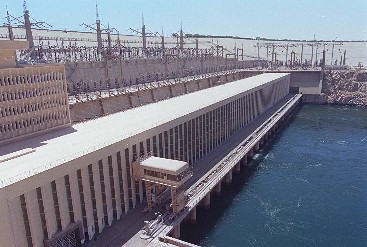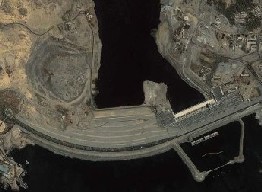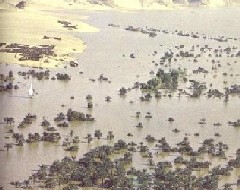|
In the year
1902, work on the dam progressed smoothly and after five
months of painstaking effort the great work was
completed by May 1902. The official opening of the dam
took place the following December, when the Khedive of
Egypt, Abbas Hilmi Pasha, opened five of the great
sluice gates to allow pent-up water to rush through the
river. The work on the dam had cost over five million
pounds. It had swallowed over a million tons of granite,
75000 tons of cement and 6400 tons of steel work. The
sluice gates constructed into the dam were considered to
be marvels of engineering for each of them was capable
of being worked with ease, although, at the lowest level
of water it has a pressure of 200 tons against it!
During the season when the Nile is in flood, more than
15000 tons of water passes through its sluices every
second. The gates were left open in flood time, so that
water from the Nile could move through it freely and
convey its life-giving silt to the lower reaches of the
land. As the flood diminished the gates were closed to
store up the required amount of water to be used at a
later date.
Gigantic as the
work was, it soon became necessary to improvise upon the
existing work. The surging torrents of the River Nile
sweeping through the sluices had begun to scour out the
riverbed forming a deep hollow in it near the base of
the dam. The engineers feared that this in turn would
affect the stability of the foundations of the dam and
it was soon decided to cut out all the defective and
loose rock at the foot of the dam, and a huge slope of
granite blocks provided as a protection to the river bed
so that the water running through the sluices is carried
forward by 200 feet until it reaches the original
riverbed. This work required an additional 350,000 tons
of masonry and the cost of building it came to nearly
350,000 pounds.
Although, the
huge reservoir formed by the dam was completed in the
year 1902, and the water stored in it allocated to the
surrounding regions by the end of 1903, it became soon
apparent to the British engineers working on the dam
that it was not sufficient to meet the needs of the
farming community of the Nile Delta, and there was an
urgent need to increase the height of the dam. In 1907,
Sir Benjamin Baker, one of the engineers working on the
dam was given the task of designing an addition to the
reservoir that would increase its capacity by 2250
million tones. The problem of increasing the height of
the dam and strengthening it to hold two- times as much
water was one of the most difficult problems ever solved
by the dam construction engineers.
The dam had to be raised
by 16 feet, and the depth of the water behind it by 23
feet. And, the construction of the dam required the
structure to be thickened as well as raised
simultaneously. Sir Benjamin’s design left a space of 6
inches between the new wall of the dam and the original
wall with the two joined together by a number of steel
rods. The rods bearing the weight of the new face
allowed room for cementing the dam. After the front
portion was built in the year 1907-09 the gap was filled
with cement mortar, and the two walls of the dam were
bound together to make a solid whole. During 1910-12 the
heightening of the dam was carried out, and ten years
after the opening of the original structure the enlarged
dam was brought into use. The additional work had
incurred a cost 1,500,000 pounds and used up 400,000
tons of masonry, so that the dam as a whole contained
nearly two millions tons!

In the year 1929, the
Government of Egypt again set up an International
Commission comprising of an American, a Swiss and a
British Engineer to advise it on the feasibility of
further heightening the dam to increase its capacity to
hold water and to recommend the most suitable design for
the purpose. In its report the Commission informed that
the dam could safely raised by another 29 feet 6 inches;
and the level of the reservoir increased by 26 feet.
Work on the new scheme was commenced early in 1931, and
carried on without interruption towards the end of 1933.
The dam was now 6987 feet long compared to 6428 feet in
1902, and its maximum height was 174 feet compared with
the 128 feet of the original structure. The raising of
the dam made it necessary for the construction of 90 new
sluices, and in addition, the reconstruction of the
remainder. The reservoir formed by the heightened dam
now held about 5000 millions tons of water, and incurred
a cost of ten million pounds.
The River Nile had been
tamed but only partially. While the raising of the Aswan
dam was in progress, a barrage similar to those at
Assiut and Isna but capable of holding a much greater
amount of water was constructed at Nag Hamadi, and
opened in 1930. On the other side of Egypt the water
from the river first passed through Sudan and it was
decided that Sudan should also reap some of the benefit
from the River Nile. However the Egyptians were
apprehensive that any work on a dam in Sudan would
affect Egypt’s supply of water from the Nile. But the
fears of the government were allayed when it was pointed
out that an enormous quantity of water was wasted in the
middle of July when Egypt had all the water she could
use and the rest was passed into the sea. Experiments
also showed that during the months of February to
October, the Egyptian period of cultivation, the climate
in Sudan was too hot for cotton growing, but crops could
be sown in July and picked in the month of February or
March with every success.
A scheme was therefore
prepared for impounding the waters of the Blue Nile to
irrigate the Gezirah (island) region, which lies between
the Blue Nile and the White Nile just south of Khartoum
by the aid of a dam across the Blue Nile at Sennar, 2000
miles from the mouth of the Nile. This dam was first
suggested around 1904 by Sir William Garstin, one of the
pioneers of Egyptian Irrigation Service and the founder
of its Sudan. Work on the dam commenced before the First
World War-although plans were drawn for it much
earlier-but was abandoned soon after. The construction
was continued after hostilities ceased and the Sennar
Dam was officially opened on 21st January
1926.

In order to build the
Sennar Dam, the river was temporarily diverted by means
of sudds, first to the western channel and then to the
eastern channel. The great dam built was nearly two
miles long and 120 feet high and it took over a million
tons of stone brought from 20 miles to the site. Its
base was 90 feet thick and tapered to 15 feet at the
top. Around 20,000 men were employed to do the job and
the workforce was made up of both Egyptians and Sudanese
nationals, along with 350 skilled Egyptian masons.
Other workers were hired to work on the dam were from
Arab countries on the other side of the Red Sea, Nigeria
and French Congo. A hundred thousand tons of cement, and
3500 tons of steelwork were placed in the dam, which
holds back the water for a distance of 58 miles.
Eighty main
sluices, 14 canal sluices and 112 spillways were
constructed into the dam and the water stored would be
used later to irrigate 460,000 acres of land without
taking any water supply that was required for the needs
of Egypt. The only water that was stored being that of
which would otherwise be emptied by the Nile into the
Mediterranean Sea. The cost of the whole project was
around ten million pounds.
An agreement was
made in 1928 that gave the Egyptian Government the right
to control the waters of the Nile outside Egypt, and as
a result work commenced in 1933 on a dam at Jabal Aulija
in the Sudan, 20 miles south of Khartoum. As the White
Nile Valley from south of Khartoum was extremely flat,
it was possible to impound a great volume of water by a
dam of modest height. Work on the dam was started in
November 1933 and was completed in April 1937. The
completed dam was the longest in the Egyptian system.
The reservoir that resulted by the construction of the
dam was 187 miles long and four miles wide in parts had
been formed and the dam was capable of holding 3000
million tons of water. Its purpose was to pass on water
to Aswan and served the same purpose as if the capacity
of the Aswan reservoir were increased again.
Still more
colossal projects for conserving the Nile waters became
inevitable due to meet the needs of the ever-growing
population of Egypt. The stage was set for building the
Aswan High Dam when the old dam overflowed in the year
1946.The engineers monitoring the dam decided that
instead of raising the dam for the third time, it would
be better to build another one with a larger capacity
six kilometers from the original dam. Planning for the
dam started in the year 1952, after Gamal Abdul Nasser
seized power in Egypt, and at first the United States
offered to fund its construction with a loan of $270
million. Bids for construction of the dam were invited
from British, French and German firms. When the aid
offer was withdrawn in the year 1956, after Egypt
formally recognized the People's Republic of China,
Nasser decided to proceed with its construction with the
help of the revenues earned through the ships passing
through the Suez Canal.
By then, the
Soviet Union struggling to increase its zone of
influence in Africa during the Cold War offered to help
in the construction of the dam and agreed to finance it
on the condition that only Soviet equipment and
engineering methods were used in the construction of the
dam. The Russian Zuk Hydro-project Institute designed
the enormous rock and clay dam that was built and later
called as the Sadd al-Ali Dam. More than 800 Soviet
engineers and technicians were sent to the site to guide
the work. But, Sadd al-Aali was not destined to be an
entirely Russian dam. The workforce of 30,000 at the dam
included men from many nations, among them Finland,
Switzerland, India, Ghana, Canada, Argentina and the
United States. Equipment to the site also came from
different parts of the world: bulldozers from USA,
excavators from Britain and Swedish rock drills.
 
Construction on
the High Dam started in the year 1960. The High Dam, Al
Saad al-Aali with its grand display of stone and steel
was completed on July 20, 1970. The dam was 3600
meters long, 980 meters at its base, and had a room for
a highway 40 meters wide along its crest and is 111
meters tall. Its first stage finished in the year 1964
and the reservoir was filled in 1964 when the dam was
still being constructed. It became Egypt�s biggest, most
colossal monument that was ever built since the
construction of the Great Pyramids of the ancient times.
According to estimates, the dam holds 55 million cubic
yards of material-masonry, rock and steel-enough for
constructing 17 Great Pyramids The Aswan dam had
increased Egypt’s cultivable land by 30% and created a
reservoir of water so vast that it could hold Egypt�s
water supply for a number of years so that the Nile
could be regulated during its high or low annual flood
at all times. And, it also created Lake Nasser, the
world�s largest man-made lake, which raised the water
table in the Sahara as far as Algeria. The generators at
the hydroelectric power station at the Sadd al-Aali-the
Aswan High dam- are capable of spinning out ten billion
kilowatt hours of electricity annually to power industry
in Egypt and allowed for the connection of most Egyptain
villages to electricity for the first time.
Unfortunately all
these advances came with a price. Water impounded by the
Aswan High Dam would submerge some of Egypt�s chief
tourist attractions, the prehistoric temples at Abu
Simbel, and the government looked for ways to save the
two temples there. Suggestions came cheap, but the price
tags came as high as 90 million dollars. The engineers
had to move two temples literally carved out of the
living rock of a mountainside. The front portion of the
temple with its four colossal figures, the sandstone
portrait of Ramases II stood 110 feet high, and 125 feet
high. The Great Hall, wide rooms, and inner sanctuaries
burrowed 200 feet into the mountain. And, the other
temple a shrine to Nefertari was small by comparison: 40
by 90 feet from the outside and 70 feet from the
entrance to the back wall. Early proposals at saving
these monuments called for cutting each temple out in
one gigantic piece and raising it to the top of the
cliff to its new site, about the height of a 19-story
building. The U.A.R considered this, and wisely tossed
the problem to the world, through UNESCO. An intensive
fund-raising campaign began, and more ideas to save the
temples were solicited. By then the first stage of the
dam was nearing completion and the water levels in it
were rising by the day. Forced to a decision the UNESCO
and U.A.R accepted a Swedish plan: carve the monuments
into manageable blocks, haul them a block at a time, and
resemble them at the cliff-top, at a cost of 36 million
dollars.
Ever since
prehistoric times, Egypt had been overtaken by famine,
due to the Nile not rising sufficiently to flood the
land. During those years the Egyptians had suffered from
Low Nile and crop failure. Until the middle of
nineteenth century the River Nile had been left to chart
out its own path, and Egypt was entirely at its mercy
unable to check its flow. Today, the people of Egypt can
look back with pride on the harnessing of the Nile and
to the outstanding contributions made by the dams to the
material progress of Egypt. Above all, the great dams of
Egypt are now capable of parceling out water saved from
the fat years to nourish the lean. |
